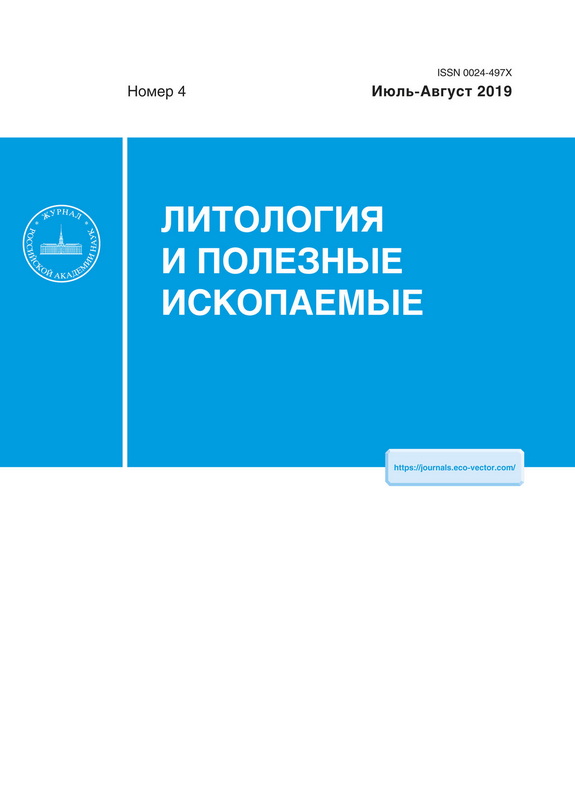No 4 (2019)
- Year: 2019
- Articles: 5
- URL: https://journals.eco-vector.com/0024-497X/issue/view/916
- DOI: https://doi.org/10.31857/S0024-497X20194
Articles
Glauconite of terrigenous-carbonate deposits from the lower Cambrian (Northern Siberia, Olenek uplift)
Abstract
The detailed mineralogical peculiarities are reported for the first time of the glauconite of the Lower Cambrian (Tommotian stage) extracted from the terrigenous-carbonate deposits at the upper part of the Kessyusa series (the roof of the Mattaia Formation and the lower part of the Chuskuna Formation) as well as basal layers of the overlying limestone, too. Samples were taken from three sections of north-western slope of the Olenek uplift, northern Siberia; their stratigraphic position is given on the basis of modern data [Nagovitsin et al., 2015, and others]. Grains of layer silicates are represented by mica-smectite phyllosilicates with a relatively low content and with an elevated content of smectite layers (<10 and 10–20%, respectively), (the unit-cell parameter b = 9.06–9.12 Å). Micaceous minerals form a range from glauconite to Al-glauconite (КAl = VIAl/(VIFe3+ + VIAl) = 0.11–0.47 и 0.60, respectively; K2O content is 6.80–8.54%. Detailed litho-mineralogical peculiarities of glauconite-bearing sediments are given for the first time. Their primary deposits according to [Marusin, 2016] accumulated in the conditions of the shoreface and the offshore-transition zone of the Siberian epicontinental marine paleobasin. The origin (autogenic, allothigenic) of the studied grains, their secondary changes (rewashed in situ, phosphatization, pyritization, calcitization, ferruginization, etc.) at different stages of lithogenesis are discussed. It is shown that the obtained preliminary Rb-Sr dates (450–320 Ma) were ”rejuvenated”: they do not meet the age values previously adopted for the the Vendian-Lower Cambrian boundary — 541.0 Ma [Gradstein et al., 2012]. This may be due to various secondary alterations of glauconite grains during rewashing, transportation, and also at different stages of diagenesis in primary sediments and after re-deposition, as well as at the stages of catagenesis (deep diagenesis) and hypergenesis of glauconite-bearing rocks.
 295-317
295-317


Sorption of Y 3+, La 3+ AND Се 3+ cations on the cobalt-rich manganese crusts of the Magellan Rise and Marcus-Wake seamounts, Pacific Ocean
Abstract
Cobalt-rich manganese crusts and crust-concretion formations from the guyots of the Pacific Ocean were found to be the natural highly selective sorbents of rare-earth cations Ce3+, Y3+, La3+. Ion exchange capacity of ore minerals — vernadite, Fe-vernadite and Mn-ferroxyhyte — increases in the following sequence La3+
 318-336
318-336


New genetic type of leaching zones in the salts of the verkhnekamskoe salt deposit: hydrochemical, mineralogical and structural indicators
Abstract
The brine-saturated leaching zone first encountered in the salt rocks of the Verkhnekamskoe Salt Deposit is characterized in detail. It consists of a cavernous nucleus (40×70 m), composed of an aposilvinite syngenite-halite rock with gypsum and kalistroncite, and a recrystallization halo 60–80 m wide, not containing secondary sulfates. Above the leaching zone is a linear zone of weathering and decarbonization of marls above the salt layer. This zone is controlled by the anticlinal crest of the sublatitudinal strike, extending parallel to the Durinsky Trough of the sedimentary-fault nature. The penetration of supra-salt waters into a salt deposit is associated with the manifestation of deformations in the salt mass at its hinge inflection during the formation of the Durinsky deflection in the Early Permian time. The connection of the brines of the investigated leaching zone with infiltration over-salt sulfate-calcium waters was revealed and their place was determined in the general scheme of genetic typification of natural brines and waters circulating in the salt deposit of the Verkhnekamskoe Salt Deposit.
 337-350
337-350


Pore space of carbonate tidalites — paleoclimatic aspect
Abstract
Carbonate deposits of tidal zones are characterized by micritic structures, considerable content of clay material, wide development of cyanobacterial formations. Under arid climate conditions, dolomite tidalites are formed in association with evaporites, which contain numerous interlayers of stromatolites. Dolomitic tidalites make up the lower and upper elements of three-membered transgressive-regressive cyclites, and talidites deposited in a humid climate lie at the base of two-membered cyclites composed of limestone. The pore space is very specific in both cases, due to the wide development of bacterial formations, and this determines the sharp permeability anisotropy.
 351-363
351-363


Rare elements — setting markers of the formation of the manganese and iron ore deposits of Kalahari and Postmasburg areas (South Africa). Communication 1. Kalahari manganese field
Abstract
In manganese ores of the Hotazel Formation (Transvaal supergroup) of the Lower Proterozoic, associated with banded ferrous silicites, high concentrations of a number of rare elements (B, Ge, W, Mo, Cr, Ni, Zn, Cd, Pb, Ag, Bi, As, Sb, Te, Se) were determined. High boron contents in oxide-carbonate ores (manganese lutites) are considered as a consequence of the concentration by chemsorbtion of this element on Mn-carbonates. It is proposed that as a result of hydrothermal transformations, a wide range of ore-forming (mainly Fe, Mn) and rare elements (including REE) was removed from the underlying andesite-basaltic hyaloclastite Ongeluk Formation In manganese ores and ferruginous silicites, typical values of cerium (Ce/Ce* 0.28–1.72) and europium (Eu/Eu* 0.57–16.31) anomalies were established, which may indicate that the initial sediments accumulated in the marginal shallow sea basin with a pronounced oxide surface water layer and close to anoxide conditions near the bottom. Metalliferous (Mn, Fe) sediments of a shallow water basin at different stages of lithogenesis were enriched with europium (positive Eu/Eu*), subjected to metasomatosis (with redistribution of manganese and the formation of manganese carbonates) and, subsequently, regional metamorphism (up to the stage of sericitic green schists).
 364-386
364-386











